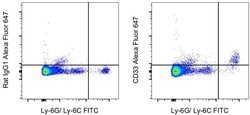Learn More
Invitrogen™ CD33 Monoclonal Antibody (9A11-CD33), Alexa Fluor™ 647, eBioscience™, Invitrogen™
Rat Monoclonal Antibody
Supplier: Invitrogen™ 51033182

Description
Description: This monoclonal antibody 9A11-CD33 reacts with mouse CD33, also known as Siglec3 and gp67. CD33 belongs to the sialic acid-binding immunoglobulin lectins (Siglec) family that binds to sialic acid-containing glycans on cell surface glycoproteins and glycolipids on mammalian cells. Mouse CD33 binds to short O-linked glycans of certain mucins and sialyl-Tn epitopes. Mouse CD33 is expressed by mature granulocytes, immature myeloid cells, and microglia. Unlike human CD33, mouse CD33 lacks a cytoplasmic ITIM domain and exists as two splice variants that have different cytoplasmic tails. In microglia, CD33 inhibits the phagocytosis of toxic amyloid beta. Clone 9A11 has been used to characterize mouse CD33 surface expression and function. <a href=https://www.ncbi.nlm.nih.gov/pubmed/31925286>View Article</a>. Applications Reported: This 9A11-CD33 antibody has been reported for use in flow cytometric analysis. Applications Tested: This 9A11-CD33 antibody has been tested by flow cytometric analysis of mouse splenocytes. This may be used at less than or equal to 0.125 μg per test. A test is defined as the amount (μg) of antibody that will stain a cell sample in a final volume of 100 μL. Cell number should be determined empirically but can range from 10^5 to 10^8 cells/test. It is recommended that the antibody be carefully titrated for optimal performance in the assay of interest. Excitation: 633-647 nm; Emission: 668 nm; Laser: Red Laser
CD33 is a transmembrane protein of the sialic acid-binding immunoglobulin-like lectin (Siglec) family. It belongs to the immunoreceptor tyrosine-based inhibitory motif (ITIM)-containing molecules able of recruiting protein tyrosine phosphatases SHP-1 and SHP-2 to signal assemblies, and these ITIMs are also used for ubiquitin-mediated removal of the receptor from the cell surface. CD33 is expressed on cells of myelomonocytic lineage, binds sialic acid residues in N- and O-glycans on cell surfaces, and is a therapeutic target for acute myeloid leukemia. Further, CD33 is found on granulocyte and macrophage precursors in the bone marrow, but is not on pluripotent stem cells. CD33 is also expressed on, and is a useful marker for, peripheral monocytes. CD33 is useful for distinguishing myelogenous leukemia cells from lymphoid or erythroid leukemias. Diseases associated with CD43 dysfunction include gallbladder lymphoma and extracutaneous mastocytoma.
Specifications
| CD33 | |
| Monoclonal | |
| 0.2 mg/mL | |
| PBS with 0.09% sodium azide; pH 7.2 | |
| Q63994 | |
| CD33 | |
| Affinity chromatography | |
| RUO | |
| 12489 | |
| 4°C, store in dark, DO NOT FREEZE! | |
| Liquid |
| Flow Cytometry | |
| 9A11-CD33 | |
| Alexa Fluor 647 | |
| CD33 | |
| CD33; CD33 antigen; CD33 antigen (gp67); CD33 molecule; CD33 molecule transcript; FLJ00391; gp67; Myeloid cell surface antigen CD33; p67; sialic acid binding Ig-like lectin 3; sialic acid-binding Ig-like lectin 3; SIGLEC3; Siglec-3 | |
| Rat | |
| 100 μg | |
| Primary | |
| Mouse | |
| Antibody | |
| IgG1 κ |
Safety and Handling
The Fisher Scientific Encompass Program offers items which are not part of our distribution portfolio. These products typically do not have pictures or detailed descriptions. However, we are committed to improving your shopping experience. Please use the form below to provide feedback related to the content on this product.
